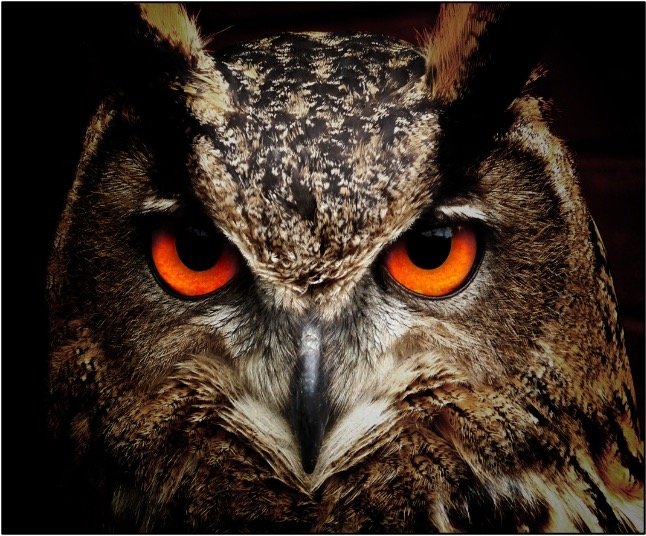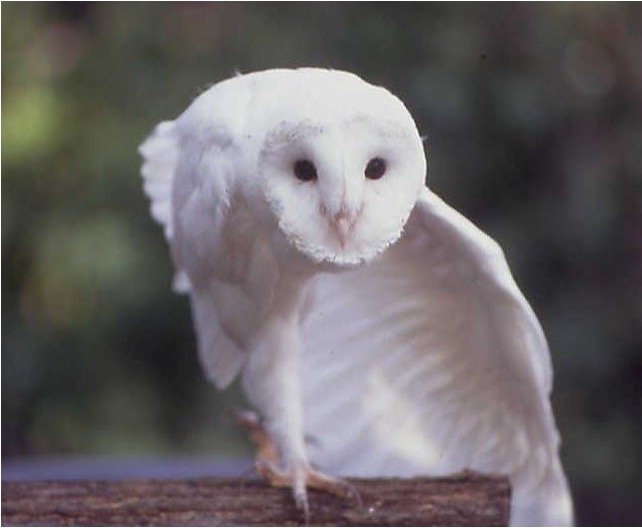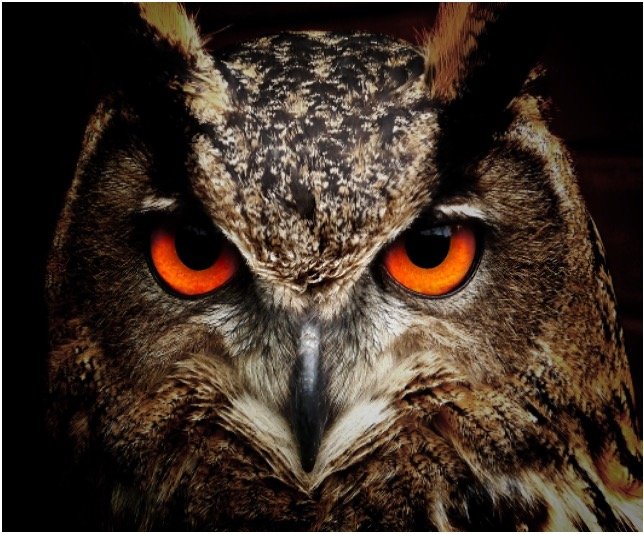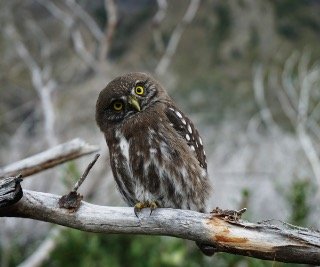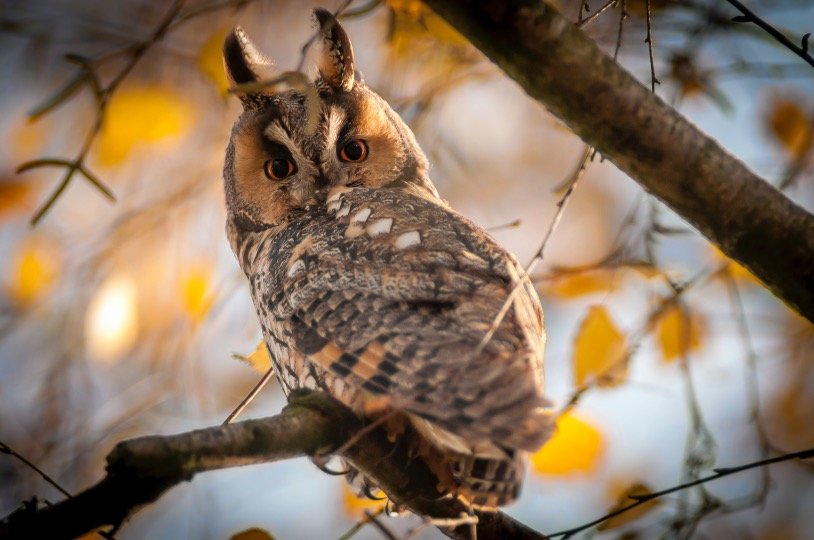
Owls in Georgia
What makes the Peach State’s natural environment unique is that it encompasses more than just luscious fruits, metropolitan surroundings, and weeping willows. Instead, hardwood forests may be found over most of Georgia’s northern regions.
To the south, there are several different types of wetland, including wooded, deciduous, evergreen, and shrub wetlands. These wetlands provide a key habitat for the majority of the flora and wildlife in South Georgia and are therefore protected by law.
15 Cutest Owls In The World
Georgia’s five habitat regions are the mountains, piedmont, coast, wetlands, and coastal plain. Georgia is home to a plethora of bird species, including several owl species, that thrive in the state’s diverse ecology. In order to comprehend what owls can be found in Georgia, it is necessary to first grasp what they are.
Georgia is home to nine different owl species, which include the;
- Barn Owl
- Barred Owl
- Burrowing Owl
- Eastern Screech-Owl
- Great Horned Owl
- Long-eared Owl
- Northern Saw-whet Owl
- Short-eared Owl
- Snowy Owl
Even while many of these owls are part-time, seasonal inhabitants of Georgia, others are long-term members of the state’s diverse wildlife community. Continue reading to find out more about the nine owl species and their daily life!
Did you know?
The owls on the list below have been identified based on historical sighting records from a variety of sources. Despite the fact that some of the birds on this list are rare and difficult to identify, we have included them because they are occasionally observed in Georgia.
What Is Owling?
Owling is typically a gathering of birders in pursuit of a particular species of owl or owls. Owling can be a great way to add elusive raptors to your life list, but this unique type of birding has special considerations for success. Understanding the basics of how to find owls can help you go owling with great views of these elegant birds of prey.
How To Find Owls In Georgia?
In order to find a target species of owls, the searcher must become familiar with its range, habitat, and annual cycle. Behavior of target owl will also be a key in finding the owl. Additionally, the owl species is highly nocturnal, meaning it is unlikely to be seen during the day.
Where Do Owls Nest? Everything You Need To Know
However, when searching for a species like the Short-eared Owl, an owling crew would be better served searching grasslands and shrublands at dawn or dusk. Knowing the ins and outs of a target species is critical to finding owls.
Without knowledge of the natural history of a species, an owling excursion is much less likely to be successful.
When To Go Owling?
Most owls are nocturnal birds, but that does not necessarily mean they can only be seen in the darkest hours of the night. Several owls, such as burrowing owls, short-eared owls, and snowy owls, are more active during the day than most other owl species.
A moonlit night can also be a great time for owling, when the moon provides more light for effective owl spotting. The best time of day to see owls is at dawn or dusk when these birds are more easily spotted and more active.
Where I Can Find Owls? Everything You Need To Know
Most owls do not migrate and can be found in the same territory throughout the year, but certain times of year are better for owling.
Where To Go Owling?
You can look and listen for owls in wild places. That might be at a wildlife sanctuary, local wooded area or even in your own backyard!
Owls love to roost inside hollow trees so always gently check their hiding place but take care not to disturb the wildlife. You could also check online message lists, sightings reports, or contact a local birding organization for tips on where to find owls.
Tips For Successful Owling!
• Find out about the species of owls in the area you are looking.
• Bring along a pair of binoculars equipped with night vision. When owling, it is actually better to use a lower magnification, since that will let you see a greater field of vision and give you a better chance of actually finding what you’re looking for.
• Familiarize yourself with the calls of different owls you can come across and listen actively. You are more likely to hear them before seeing them.
• Owls have excellent camouflage, and their plumages are adapted to blend into the night.
• Also look out for their pellets which are oblong or spherical and brown or grey in color. A large number of pellets indicates a nearby nesting or roosting owl.
• Be still and silent, and refrain from using bright lights, so as not to disturb or frighten them away.
1. Barn Owl
- Scientific name: Tyto alba
- Length: 33cm to 39cm
- Wingspan: 80cm to 95cm
- Weight: 250g to 350g
- Observed: Throughout the year
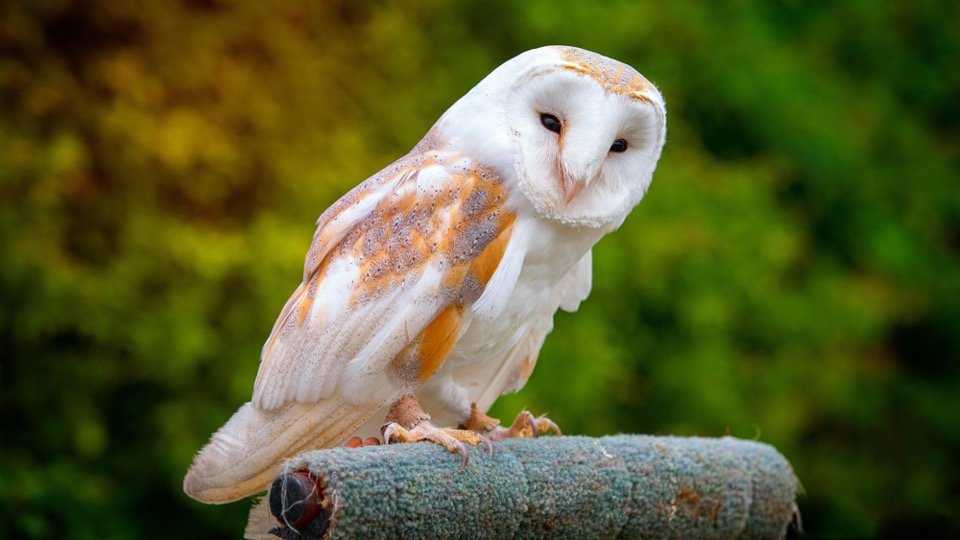
In addition to their white faces, buff underbelly and breast colouring, short tails with a grey blend, rounded wings, and lovely brown and grey backs, barn owls are also a sight to behold. Due to the fact that they form a hear shape, and because this species does not have ear tufts, their heads have a smooth appearance, their features are very distinguishable.
Listen Barn Owl Hoot
Credit: Manceau Lionel, XC659876. Accessible at www.xeno-canto.org/659876.
Barn Owls have medium-length bills that are pinkish-gray in colour. Barn Owls prefer to nest in man-made structures such as barns, but they prefer to hunt in open places such as marshes and fields, as the name implies.
This species primarily preys on other avian and small mammal prey, including as rabbits, rats, and mice, among other things.
Because they hunt at night, they favour species that are active at night, such as squirrels and chipmunks, which are generally safe from this owl. The Barn Owl can be found all year in northern and southern Georgia, where it can be observed.
2. Eastern Screech-Owl
- Scientific name: Megascops asio
- Length: 16cm to 25cm in length
- Wingspan: ranging from 48cm to 61cm
- Weight: 170g to 190g
- Observed: Throughout the year

The Eastern Screech Owl is a tree-loving creature whose complex plumage allows it to blend in with the foliage. This owl can be found year-round in various sorts of woodlands, but it prefers areas where there is water nearby.
The Eastern Screech-Owl eats a variety of small mammals, including earthworms, lizards, frogs, tadpoles, crayfish, and any other small mammal that comes into its territory. This is due to the fact that this owl is little and enjoyable to observe.
Listen Eastern Screech Owl Hoot
Credit: Lance A. M. Benner, XC513355. Accessible at www.xeno-canto.org/513355.
Their feathers are a collection of spots with rusty-red or grey bands, which contrast with their small and robust bodies. There are little, rounded wings on their backs, as well as a square tail.
In terms of appearance, they have a V-shape above the eyes and pronounced ear-tufts. When it comes to eastern screech owls, the Eastern Screech Owl is the most prevalent in Georgia, and the piercing yellow eyes of this bird are much simpler to notice than the owl itself.
3. Great Horned Owl
- Scientific name: Bubo virginianus
- Length: 46cm to 63cm in length
- Wingspan:140cm
- Weight: 910g to 2.5kg
- Observed: Throughout the year

Great Horned Owl Known as one of the most recognisable owls on the globe, the Great Horned Owl embodies the image that most people have in mind when they think of an owl.
With its grey plumage, medium-length tail, rounded face with reddish colouring in a heart shape, “v”-shaped eyebrows, and pointed bill; this species stands out from the rest of the bird world.
Listen Great Horned Owl Hoot
Credit: Lance A. M. Benner, XC545009. Accessible at www.xeno-canto.org/545009.
You may also identify a Great Horned Owl by its conspicuous ear tufts and the occasional flash of red on the breast of the bird. These huge owls are apex predators that can be found in a wide variety of settings.
While they prefer to dwell in deciduous or evergreen woodlands with clearings, the Great Horned Owl can be seen in a variety of habitats throughout the year, including suburban areas, tundra, desert, and a variety of other situations.
This species, which is a skilled hunter, preys on creatures that are larger than themselves, including other predatory birds. During the times when he is not hunting for huge food, this owl feeds on mice, scorpions, and other tiny creatures.
4. Snowy Owl
- Scientific name: Bubo scandiacus
- Length: 53cm to 66cm in length
- Wingspan:125cm to 166cm in length
- Weight: 710g to 2.95kg
- Observed: Occasionally, though usually during the winter

Snowy Owls are difficult to come by in Georgia, but you have a little window of opportunity between December and the end of February to see one. They are easily distinguished from other birds by their striking black and white plumage.
The whiter the bird, the more probable it is to be a male; females, on the other hand, have a more concentrated concentration of colours.
Listen Snowy Owl Hoot
Credit: Petr Suvorov, XC219348. Accessible at www.xeno-canto.org/219348.
Their broad, rounded wingtips and medium-length tails, as well as their striking yellow eyes placed within a rounded and pure-white face, provide an extraordinary contrast in their appearance.
A tiny black bill distinguishes this owl species from others. Coastal or freshwater locations, pastures, or airports are the most likely places to find a Snowy Owl if you are lucky enough to see one. This species is particularly interested in hunting lemmings, but it will also eat other rodents if they are available.
5. Burrowing Owl
- Scientific name: Athene cunicularia
- Length: 19cm to 25cm in length
- Wingspan: 51cm to 61cm in length
- Weight: 170g
- Observed: Mostly between the months of October and April
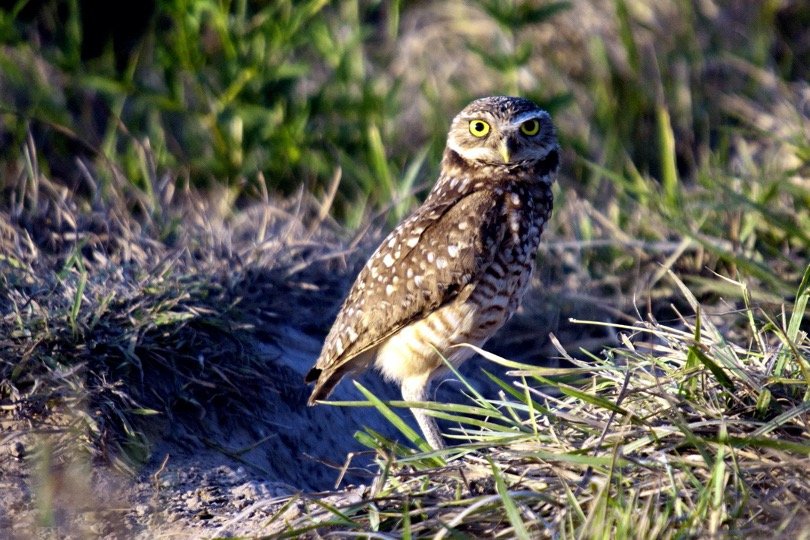
Burrowing Owl can be found in prairies and broad open areas with sparse vegetation between October and April, and it is most often seen in the fall. The Burrowing Owl is a species of owl that lives in abandoned ground squirrel burrows, as their name suggests.
They eat insects, small animals, and small reptiles that are found in their hunting territory. Burrowing Owls are distinguished by their mottled brown feathers and a mix of sandy-tan and white short tails, wings, and backs, as well as their mottled brown feathers.
Listen Burrowing Owl Hoot
Credit: David Ricardo Rodríguez-Villamil, XC524491. Accessible at www.xeno-canto.org/524491.
Their bellies are largely white with brown bards running across them, as well as white eyebrows and a white throat. In addition to their characteristic yellow eyes, this species has a medium-length beak that is either yellow or grey in colour.
Despite the fact that they are not afraid of staying still for long periods of time or hopping around on the ground, this owl species is one of the most difficult to locate in Georgia.
6. Barred Owl
- Scientific name: Strix varia
- Length: 43cm to 50cm in length
- Wingspan: 31.5cm to 35.5cm in length
- Weight: 470g to 1.05kg
- Observed: Throughout the year
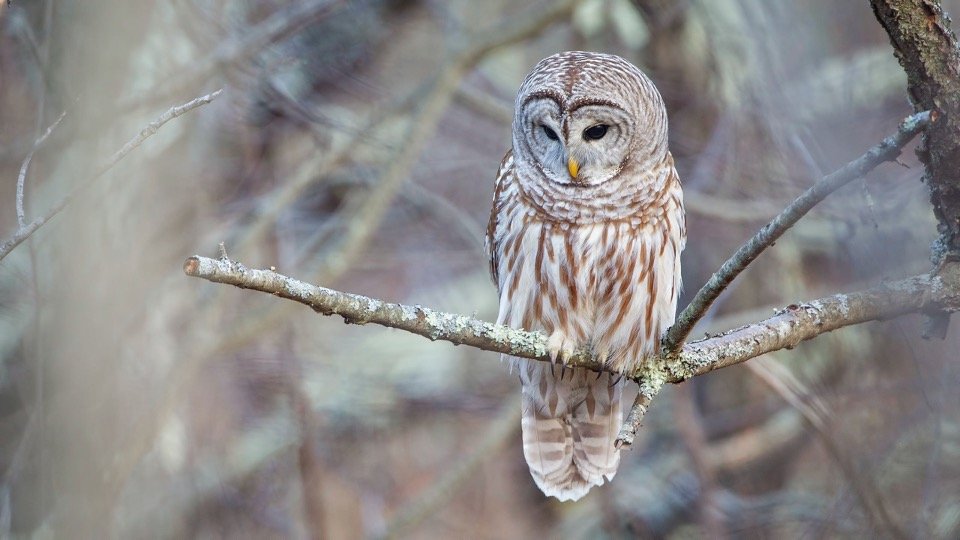
Barred Owls are totally barred in colour, with a mix of white and brown on their tails, wings, and backs. Barred Owls are also barred in shape. Their stomachs are typically a mixture of white and brown vertical lines, with brown horizontal lines running across the top of their tummies.
Listen Barred Owl Hoot
Credit: wisconagus, XC691476. Accessible at www.xeno-canto.org/691476.
Their face is shaped like a figure-eight over the eyes, and this species does not have ear tufts like other species. Barred Owls prefer deciduous and evergreen trees for their houses, but they can also be found in coniferous forests throughout the state.
They spend their time roosting in tree cavities when they are not foraging for prey. The Barred Owl enjoys diversity in its diet, and will eat anything from snakes to grouse to rabbits to any small mammal that comes its way. Georgia’s Coastal Plains are home to these magnificent birds, which can be found there.
7. Long-Eared Owl
- Scientific name: Asio otus
- Length: 35cm to 37cm in height
- Wingspan: 84cm to 95cm in length
- Weight: 210g to 370g
- Observed: It’s not common, but it happens usually between the fall and winter

Long-eared Owl Long-eared Owls are true to their name in that they have long ears that have a catlike look and are nocturnal. These cats are medium in size and have an extra-long ear tuft, as well as an orangey face that gives them the appearance of a startled cat.
Listen Long-Eared Owl Hoot
Credit: Clive Davies, XC713370. Accessible at www.xeno-canto.org/713370.
Due to the fact that this species is largely silent throughout the year, they maintain a low profile. During mating season, however, they become chatterboxes, emitting a low “whoo’s” sound to seek a mate’s attention.
Long-eared Owls are difficult to come by in Georgia, but your best chances of seeing one are during the fall and winter months. You can find them in any part of the state, with the exception of the southeastern portion.
In order to nest, hunt, and roost, the Long-eared Owl prefers open places where there are dense shrubs and trees.
They mainly prey on small animals and rodents found in the area, such as voles, mice, rats, and gophers, but they have also been reported to consume snakes, lizards, bats, shrews, and other small birds in addition to these.
8. Short-Eared Owl
- Scientific name: Asio flammeus
- Length: 34cm to 42cm in length
- Wingspan: Approximately 90cm to 105cm
- Weight: between 260g and 350g
- Observed: In most cases, from November to April.
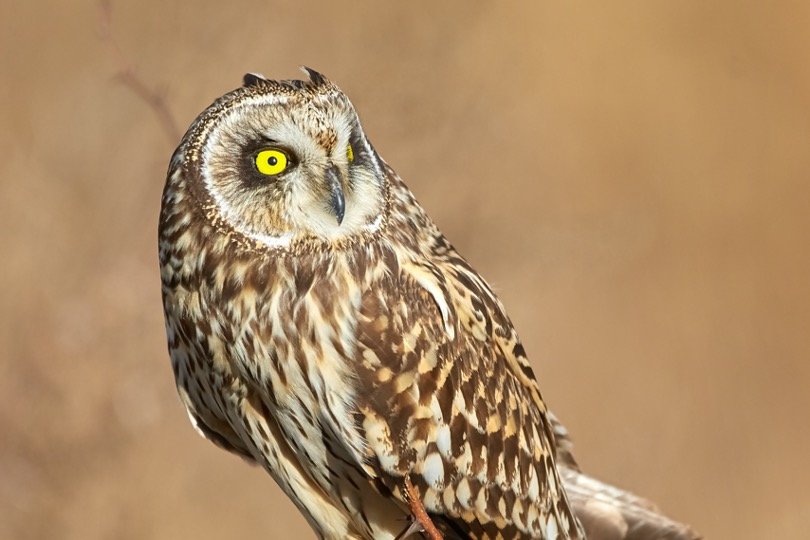
Short-eared Owl Its short tail and rounded wings, as well as a magnificent mixture of white, buff, and brown speckled plumage over their backs, distinguish the Short-eared Owl from other owls.
Their wings will typically have a single white patch on the underside, which will aid you in identifying them. The undersides of the bird’s wings are marked with a comma-shaped marking near the bird’s wrist.
Listen Short-eared Owl Hoot
Credit: Romuald Mikusek, XC669188. Accessible at www.xeno-canto.org/669188.
This species’ face is characterised by yellow eyes that are outlined in black and have a white centre that is disrupted by tan and brown dots that extend from their forehead throughout the rest of their face.
These owls are distinguished by their modest ear tufts and small black bills. In meadows, fields, and other open spaces where they hunt, the Short-eared Owl can be found from November to April at its most active, which is during the day.
In addition to the rare bird and small mammal, this species’ regular diet includes insects, especially in the case of younger owls.
9. Northern Saw-whet Owl
- Scientific name: Aegolius acadicus
- Length: 18cm to 21.5cm in length
- Wingspan: 45cm to 60cm in length
- Weight: 100g
- Observed: Between November and February, but this is an unusual occurrence

With its huge head, this charming tiny owl has a cartoon appearance, which makes them even cuter. In addition to having white spots on their wings and backs, they also have brown streaking on their breasts and tummies that is interspersed with solid white lace.
A figure 8 face composed of shades of white and brown surrounds their bright yellow eyes, which are set in the centre of their heads. They have no ears and have no ear tufts on their heads.
Listen Northern saw-whet Owl Hoot
Credit: Lance A. M. Benner, XC446701. Accessible at www.xeno-canto.org/446701.
The bill of the Northern Saw-wet Owl is short and black in colour. This species can be found largely in forests, but it can also be found in vast open regions where it hunts for squirrels, deer mice, small birds, and insects.
It can be found in forests, but it can also be found in large open areas where it hunts for squirrels, deer mice, small birds, and insects. The greatest time to see a Northern Saw-whet Owl in Georgia is during a brief window between November and February, even though they are uncommon here.
